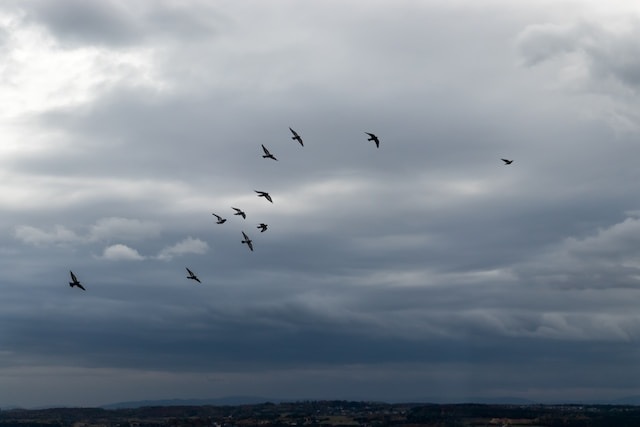Battered by gusts, birds seek refuge when Mother Nature cranks up the wind machine. But where do birds go to stay safe during windy weather?
We’ve got the answer for you! In this whimsical journey, we’ll unveil the secret hideouts of our avian buddies, reveal their quirky survival strategies, and even throw in a few surprising tales from the windy birdhood.
Get ready to soar through this fascinating exploration of feathered resilience!
Table of Contents
- 1 Why Windy Weather is Challenging for Birds
- 2 Anatomy of a Bird: How Feathers and Wings Help Them Fly
- 3 The Effects of Wind on Birds
- 4 Strategies Birds Use to Stay Safe During Windy Weather
- 5 Where Do Birds Go When It’s Too Windy to Fly?
- 6 Examples of Windy Weather Refuges for Birds
- 7 How We Can Help Provide Safe Havens for Birds During Windy Weather
- 8 Benefits of Windy Weather Refuges for Birds
- 9 FAQs: Where Do Birds Go to Stay Safe During Windy Weather?
- 9.1 Where do birds go during windy weather?
- 9.2 How do birds manage to stay aloft during strong gusts?
- 9.3 What are some natural refuges for birds during windy weather?
- 9.4 Do birds seek shelter in man-made structures during windy weather?
- 9.5 Do birds migrate during windy weather?
- 9.6 How can humans provide safe havens for birds during windy weather?
- 9.7 Do birds face any risks during windy weather?
- 9.8 Can birds stay safe by flying in groups during windy weather?
- 9.9 How do windy weather refuges benefit birds?
- 9.10 What are some resources for further reading about windy weather refuges for birds?
- 10 Conclusion: How to Provide Safe Windy Weather Refuges
- 11 Resources for Further Reading
- 12 Author
Why Windy Weather is Challenging for Birds
Windy weather can be a challenge for birds. When the wind is blowing hard, it can be difficult for birds to take off and stay in the air.
Strong gusts can also push them off course or make them lose altitude. To stay safe, birds need to find a place to take cover during windy weather.
Anatomy of a Bird: How Feathers and Wings Help Them Fly
Birds are incredible creatures, and their anatomy is part of what makes them so special. A bird’s body is designed for flight, with light bones and feathers that provide lift and help them soar through the air.
The wings of a bird are made up of feathers, which provide lift as they flap up and down. The size and shape of the wings play an important role in how a bird flies.
A bird’s feathers also provide insulation and protection from the elements. All of these features work together to help birds fly, whether it’s through windy weather or calm skies.
The Effects of Wind on Birds
Windy weather can be a serious challenge for birds. When it’s windy, birds struggle to fly and often find it difficult to stay in the air.
The wind can also disrupt their flight patterns, making it difficult to navigate. This can be especially dangerous for young birds or birds that are migrating long distances.
The powerful winds can make it difficult for birds to find food or reach their nesting areas.
Additionally, strong winds can cause birds to become exhausted and can cause them to crash into objects or fall out of the sky.
Strategies Birds Use to Stay Safe During Windy Weather
When windy weather strikes, birds have a few strategies they can use to stay safe. One of the most common strategies is to fly into the wind, which helps them stay aloft despite the strong gusts.
They also use thermals, which are columns of warm air rising from the ground, to gain altitude and soar without having to flap their wings. When they can’t fly, birds will often seek shelter in trees or other foliage.
By tucking into dense vegetation, they can protect themselves from strong gusts. Birds will also flock together, which provides them with extra stability when the wind is blowing.
Finally, some species will migrate during the winter to areas with less windy weather. This allows them to find food sources and avoid the extreme winds.
While these strategies can help birds survive windy weather, they still need safe havens to protect them from strong gusts.
Where Do Birds Go When It’s Too Windy to Fly?
When it’s too windy to fly, birds are in a tough spot. The wind can be so strong that it prevents them from taking off, and can even make it difficult to stay aloft.
So when the wind kicks up, where do birds go to stay safe?
The answer is that birds have developed a variety of strategies for surviving windy weather.
Some will seek shelter in dense vegetation, while others will take refuge in sheltered areas such as caves or hollow trees.
Birds may also congregate in large numbers in areas that offer some protection from the wind, such as the lee side of a hill or a tall building.
In addition, birds may seek refuge in the crevices of rocks or even in the crevices of man-made structures such as bridges.
These areas offer some protection from the wind and may also be warm enough to provide shelter from the cold.
Finally, some birds may seek shelter in the air itself by forming a “kettle” or group of birds that will fly together in the same direction.
This allows them to take advantage of the collective power of the group to reach higher altitudes where the air is calmer.
By employing a combination of these strategies, birds are able to stay safe during windy weather.
While it’s not always easy for them to find shelter, their resourcefulness and ingenuity helps them survive during even the most extreme conditions.
Examples of Windy Weather Refuges for Birds
When it’s too windy outside for birds to fly, they need to find refuge somewhere safe. Fortunately, there are many different places that birds can go to stay safe during windy weather.
Some of the most common windy weather refuges for birds include trees, dense shrubs, and buildings.
Trees are an excellent source of shelter for birds, as their thick branches can block strong winds and offer protection from the elements.
Dense shrubs are also helpful, as they provide a barrier between the birds and the wind.
Buildings, such as sheds and outhouses, provide an extra layer of protection, and the roof keeps the birds safe from the rain.
Other birds may choose to take shelter in man-made structures, such as porches, decks, downspouts and gazebos.
Each of these structures offers a different level of protection from the elements, so birds can choose the refuge that best suits their needs.
How We Can Help Provide Safe Havens for Birds During Windy Weather
Windy weather can be a challenge for birds, particularly since their wings and feathers help them fly. In order to stay safe during windy weather, birds need to find places to rest and shelter.
As human beings, we can help provide safe havens for birds during windy weather. Here are some ways we can do that:
One way we can help provide safe havens for birds during windy weather is by creating birdhouses, feeders, and nesting boxes.
These provide birds with places to rest and hide, and are also great sources of sustenance.
We can also make sure to keep our yards free of pesticides, so that birds have a safe place to land and feed.
We should also plant shrubs and trees that provide birds with shelter from the wind.
Another way we can help provide safe havens for birds during windy weather is by supporting organizations that are working to protect and conserve habitats for birds.
Donating money or time to these organizations can help birds find safe places to rest and feed.
Finally, we can also help provide safe havens for birds during windy weather by simply being aware of our surroundings.
Paying attention to birds when we’re outside can help us identify which areas they are using for shelter and rest.
This can help us create more bird-friendly environments and help us understand how our actions may be impacting bird populations.
By taking these steps, we can help provide safe havens for birds during windy weather, allowing them to rest and feed without fear of being blown away.
Benefits of Windy Weather Refuges for Birds
Windy weather can be a challenge for birds, making it difficult for them to fly and stay safe. Fortunately, there are a number of strategies birds use to stay safe when the weather gets windy.
One of the most beneficial strategies for birds is finding a suitable refuge. Windy weather refuges provide birds with a safe space to take shelter from the storm and wait out the wind.
There are many benefits of these refuges for birds, including better protection from predators, access to food, and a greater chance of survival.
With access to a refuge, birds can avoid the risk of being blown away or injured in the wind, while also gaining access to resources they need to survive.
Additionally, windy weather refuges provide birds with a safe place to rest and replenish their energy reserves.
Finally, having access to a refuge can help reduce stress levels in birds, allowing them to be more resilient in the face of adverse conditions.
By providing safe windy weather refuges, we can help ensure that birds are able to remain safe and healthy during these challenging conditions.
FAQs: Where Do Birds Go to Stay Safe During Windy Weather?
Where do birds go during windy weather?
During windy weather, birds have various strategies to stay safe. They may seek shelter in dense vegetation, caves, hollow trees, or man-made structures. Some birds congregate in areas that offer protection from the wind, such as the lee side of hills or tall buildings.
How do birds manage to stay aloft during strong gusts?
Birds can fly into the wind, which helps them stay aloft despite the strong gusts. They also utilize thermals, columns of warm air rising from the ground, to gain altitude and soar without excessive wing flapping.
What are some natural refuges for birds during windy weather?
Natural refuges for birds include trees with thick branches that can block strong winds, dense shrubs that act as a barrier, and areas with natural rock formations that provide crevices for shelter.
Do birds seek shelter in man-made structures during windy weather?
Yes, birds may seek shelter in man-made structures such as porches, decks, gazebos, and even bridges. These structures offer some protection from the wind and may also provide warmth and safety.
Do birds migrate during windy weather?
Some bird species do migrate during windy weather, especially during winter, to areas with less severe wind conditions. This allows them to find food sources and avoid the extreme winds, enhancing their chances of survival.
How can humans provide safe havens for birds during windy weather?
Humans can create birdhouses, feeders, and nesting boxes as safe havens for birds. Planting shrubs and trees that offer shelter from the wind in yards can also be helpful. Supporting organizations working to protect bird habitats is another way to contribute.
Do birds face any risks during windy weather?
Yes, birds face risks such as exhaustion, getting blown off course, crashing into objects, or falling out of the sky. Windy weather can disrupt their flight patterns, making it difficult for them to find food or reach their nesting areas.
Can birds stay safe by flying in groups during windy weather?
Yes, birds often flock together during windy weather. Flying in a group provides them with extra stability and allows them to take advantage of the collective power to reach higher altitudes where the air is calmer.
How do windy weather refuges benefit birds?
Windy weather refuges provide birds with a safe space to take shelter, rest, and replenish their energy reserves. These refuges offer better protection from predators, access to food, and a higher chance of survival during challenging weather conditions.
What are some resources for further reading about windy weather refuges for birds?
You can find more information about bird conservation and habitat protection from organizations such as the National Audubon Society and the US Fish and Wildlife Service. The Cornell Lab of Ornithology and the Wild Bird Center also provide detailed resources on bird behavior and needs.
Conclusion: How to Provide Safe Windy Weather Refuges
In conclusion, providing windy weather refuges for birds can be a great way to help them stay safe during difficult weather conditions.
Trees, shrubs, and other natural shelters can offer birds the protection they need to survive during windy weather.
Additionally, artificial shelters, such as birdhouses, can provide a safe haven for birds when the wind is strong.
By creating and maintaining windy weather refuges, we can help ensure that our feathered friends have a safe place to go during inclement weather.
Resources for Further Reading
The best way to learn more about windy weather and how birds stay safe is to do some further reading. Here are some great resources that provide more information on the topic:
• The Cornell Lab of Ornithology has a great article on how different bird species respond to windy weather.
• Audubon’s website provides some great tips on how to create a safe haven for birds during windy weather.
• The National Wildlife Federation has a great article on how to create windy weather refuges for birds in your own backyard.
• The International Bird Rescue website has some great information on how to create windy weather refuges for a variety of bird species.
• The American Bird Conservancy provides some great tips on how to protect birds from the dangers of windy weather.
We hope our blog post has been helpful in understanding how birds stay safe during windy weather and how we can help them do so.
With the resources listed above, you can learn even more about this topic and how to create safe havens for our feathered friends.






